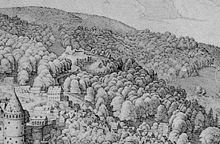Whey diet
The Molkenkur in Heidelberg is a former health resort on the Kleiner Gaisberg , which was built in the middle of the 19th century on the remains of the Upper Castle . The Molkenkur is connected to the Königsstuhl and Heidelberg Castle as well as Heidelberg's old town via the Heidelberg mountain railway.
history
At the site of the Molkenkur there was once the Upper Castle , which was destroyed in 1537 by the explosion of a powder magazine. During the Thirty Years War , a ski jump was built in its place , which was razed in 1693. In addition to walls from the time of the Thirty Years' War, a few remains of the outer bailey, the tower hill, the neck ditches and the “Teufelsloch” quarry on the north side are visible.
In 1851 the porcelain painter Albrecht Wagner bought the site and had it leveled in order to set up a whey facility with a restaurant. The name whey diet goes back to what is known as whey fasting , a special form of fasting in which users mainly ate whey and other liquids while avoiding conventional solid foods . The facility was also opened up for carriage and later automobile traffic via Neue Schlossstrasse .
In 1906 the city of Heidelberg acquired the property.
The Heidelberg mountain railway has been leading from the old town to Molkenkur since 1890 and from there to the summit of the Königstuhl since 1907. As part of the upper mountain railway, the oldest electrically operated funicular in Germany, the Molkenkur is a listed building.
literature
- Achim Wendt and Manfred Brenner: "… des lieux depuis si long-temps condamnés au silence". Archaeological search for traces on the upper castle on the Molkenkur. In: Heidelberg. Yearbook on the history of the city 2003/04. Pp. 9-40.
Web links
Coordinates: 49 ° 24 ′ 25.3 " N , 8 ° 42 ′ 46.2" E

